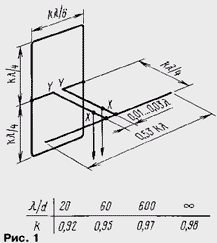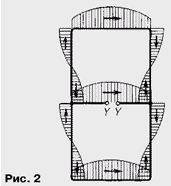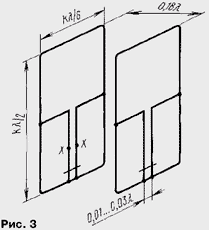Judging by foreign Amateur literature, skeletal slit the antenna is popular at frequencies above 20 MHz. In a published article an attempt to answer the question - as stated in its literature the Directive gain is true.
In the books УSW antennas have repeatedly described the so-called skeletal-slot antenna, and without exception, all publications have reported on its very high performance, large ratio of directed action (KND), wide bandwidth and ease of configuration. The idea of the proposed antenna j. Ramsey back in 1949 [1], the design shown in Fig.1, taken from [2]. The active element of the antenna consists of three parallel half-wave dipole arranged in three floors on top of each other. To reduce the size the antenna ends of the upper and lower dipoles bent at right angles in the direction to the average dipole and connected with him. From him and they are excited.
Average the dipole is made of split and paired with matching quarter-wave wire line simultaneously used for fixing the reflector. The reflector is made as wave channel in the form of single vibrator, the electrical length of which a few more half-cycle. The dimensions of the antenna in wavelengths and values the velocity factor k that depends on the diameter of the conductors (pipes) d, shown in Fig. 1. Moving the feed point along XX two-wire line, to change the input impedance of the antenna from zero (about reflector) to approximately 400 Ohms (at point YY about the active element).

The current distribution in the active element shown in Fig. 2. It is seen that antinodes (highs) current located right in the middle of the horizontal parts of the element, forming a three-story common-mode system. In the vertical parts of the active element the currents are small and are directed towards each other. In addition, there are four knots of current, so the radiation of the vertical parts in the far zone no. Recall that in the far zone is almost fully formed the radiation pattern of the antenna. The distance to the far zone is several wavelengths. It is greater, the greater directivity of the antenna.

The active element of skeletal-slot antenna can also be seen as two square combined one side and power points. However, compared to the two full size squares the perimeter of the active element of the skeletal slit the antenna is somewhat less, probably due to shortening of the action capacitance between the vertical conductors of the item. A similar antenna is proposed K. Kharchenko [3], but it powered two squares from the corners and combined points power.
From simple skeletal-slot antenna is not efficient enough reflector. To eliminate this shortcoming by running the reflector is exactly the same as the active element (in an identical three-story structure of vibrators). Two-wire line now cannot be placed between the elements, but no one bothers to hold them in the plane of each element to the point with zero potential in the middle of the bottom horizontal vibrator.
What happens after this modification, shown in Fig. 3. The dimensions of elements remain the same, and the distance between the active element and the reflector decreases to 0.18. This antenna has one more advantage. Moving on pair lines shorting jumpers, the elements can adjust it the desired frequency, and moving the jumper reflector, easy to adjust the antenna on maximum KND or the ratio of the radiation back and forth.

For such a two-element antenna described in [2 and 4] reported on an unusually high KND 14...16 dB! If the second of these books was not serious edition, then you could still pull the plug and not to take this figure seriously. But this book is overall very good and contains almost no errors. Its author, of course, could not experience all the variety shows in her designs. Therefore, if this is a mistake, it appeared earlier, in some other publications, and find the source now difficult. It is quite clear that - phase system of vibrators should give greater directivity than a single vibrator, but the question is - how? Although in [2] on p. 100 and it is alleged that the antenna "...is actually setelementat-phase three-story", but vibrators are pretty close to each other, and also shortened. It should inevitably reduce the effectiveness. Thus, questions were more than answers. Besides the familiar to the author of hams going to build that is the antenna for the 10m band and were ready to spend money on material, and it is not cheap nowadays!
To get a clear answer to the question about KND, an experiment was conducted in the range of 432 MHz. The elements were bent in accordance with Fig. 3 segment enameled copper wire with a diameter of 1.5 mm, soldered connection, and the conductors of the lines in the place of installation of guard jumpers and cable connection stripped off the insulation. The whole structure was assembled on a wooden frame dry thin strips. The power cable is passed from the feed point along the Explorer two-wire line, which connected the braid vertically down and connected directly to the output of the generator of standard signals. Indicator field served as a half-wave dipole to the detector and a microammeter. It was located on a tripod at a distance of several meters from the antenna. Antenna also fixed on primitive swivel tripod, which allowed you to change its orientation.
Tuned antenna quite easily and quickly, simply, to the maximum radiation in the main direction. When the specified dimensions at a frequency of 432 MHz distance closing jumper from the base of two-wire lines for a tuned antenna turned out such: the reflector is 43 mm, the active element is 28 mm. The distance to the connection point 50 Ohm cable was 70 mm.
When you configure the maximum KND revealed a small posterior lobe. Adjusting the reflector, it can be suppressed almost completely. Radiation to the side, up and down was absent.
KND, more precisely the gain of the antenna is equal to the product of directivity and efficiency, was determined as follows: the indicator was noted the level of the signal generated by the antenna in the main direction, then instead of the antenna to the power cable was connected half-wave dipole located at the same point in space. The signal level from the generator was improved enough to get on the same indicator testimony. Counted on generator attenuator the signal level changes numerically equal to the gain of the antenna relative to a half-wave dipole. For this the antenna he was equal to 7 dBd. Relatively isotropic (Omni-directional) emitter it will be 2.15 dB more and will be about 9.2 dBi.
Note the letters d and i in the symbol dB - in the literature on the antennas so decided to specify as to which of the radiator measured KND. Beam width at half power was in the horizontal plane (azimuth) of about 60° and in the vertical plane (on the elevation angle) of about 90°. Having these data, KND can be calculated and another method: the solid angle into which the antenna radiates equal to the product of linear angles corresponding to the width of the diagram and is expressed in radians. Get a value of about 1.5 per steradian. At the same time, the isotropic antenna radiates in the solid angle 4π, or 12.6 per steradian. KND by definition is the ratio of these physical corners and is 12.6/1,5 = 8,4 or of 9.2 dBi.
Having such a good coincidence of the values KND, determined by two methods, the author decided that the measure is nothing more and with a slight disappointment once again convinced that miracles in antenna technology does not happen. However, the antenna works very well and at small dimensions (330x120x120 mm in the range of 432 MHz) provides a very decent win.
Literature
Author: Vladimir Polyakov (RA3AAE)






